Implementing Policy in Healthcare
VerifiedAdded on 2023/06/10
|13
|3897
|207
AI Summary
This article discusses the implementation of policies in healthcare, its practical application, challenges, relevance from a public health service management perspective, usefulness to improve equity in health access, and evaluation of the policy in terms of impact and financial viability.
Contribute Materials
Your contribution can guide someone’s learning journey. Share your
documents today.

Running head: IMPLEMENTING POLICY IN HEALTHCARE
Implementing Policy in Healthcare
Name of the student
University name
Author’s note
Implementing Policy in Healthcare
Name of the student
University name
Author’s note
Secure Best Marks with AI Grader
Need help grading? Try our AI Grader for instant feedback on your assignments.
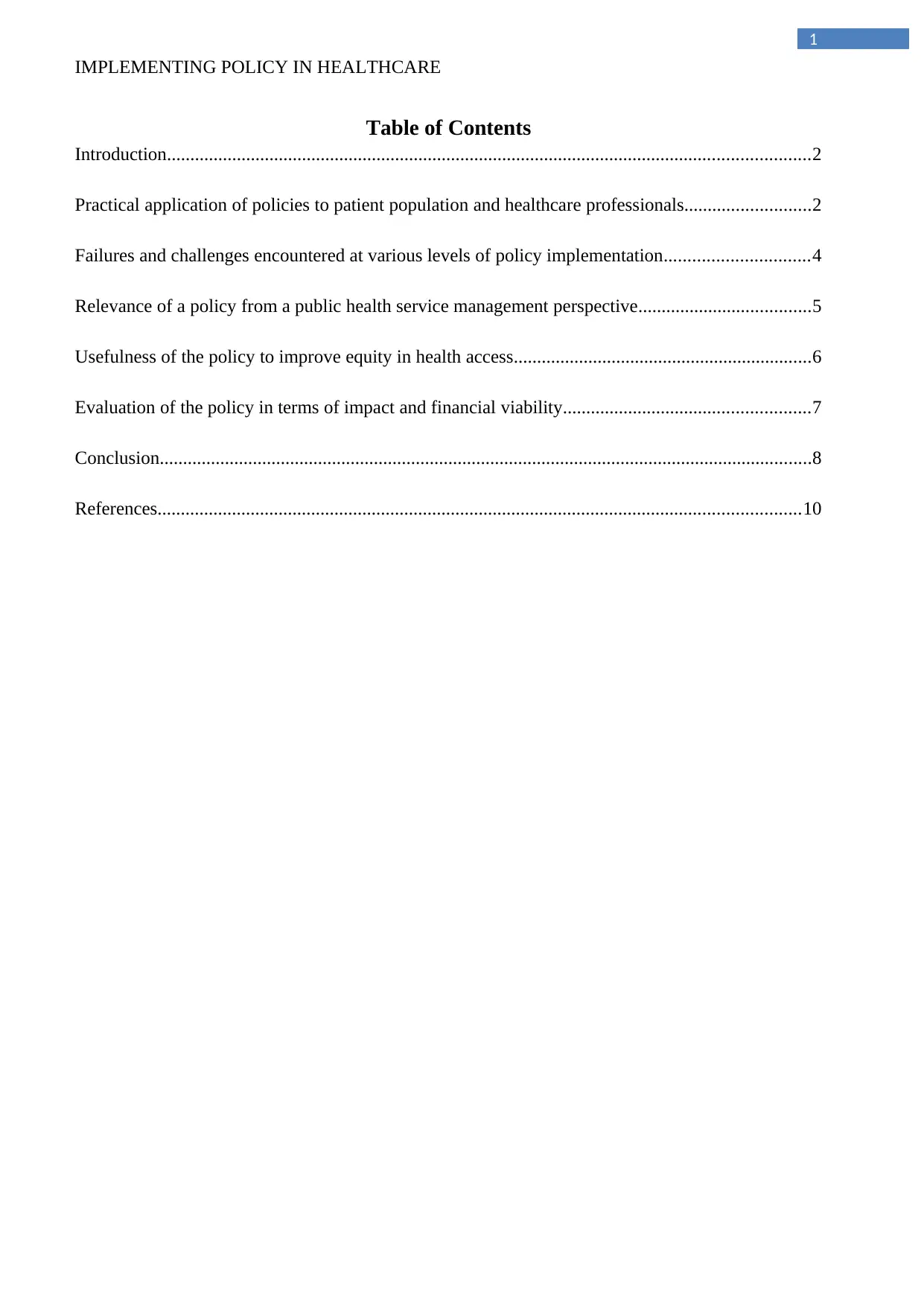
1
IMPLEMENTING POLICY IN HEALTHCARE
Table of Contents
Introduction..........................................................................................................................................2
Practical application of policies to patient population and healthcare professionals...........................2
Failures and challenges encountered at various levels of policy implementation...............................4
Relevance of a policy from a public health service management perspective.....................................5
Usefulness of the policy to improve equity in health access................................................................6
Evaluation of the policy in terms of impact and financial viability.....................................................7
Conclusion............................................................................................................................................8
References..........................................................................................................................................10
IMPLEMENTING POLICY IN HEALTHCARE
Table of Contents
Introduction..........................................................................................................................................2
Practical application of policies to patient population and healthcare professionals...........................2
Failures and challenges encountered at various levels of policy implementation...............................4
Relevance of a policy from a public health service management perspective.....................................5
Usefulness of the policy to improve equity in health access................................................................6
Evaluation of the policy in terms of impact and financial viability.....................................................7
Conclusion............................................................................................................................................8
References..........................................................................................................................................10
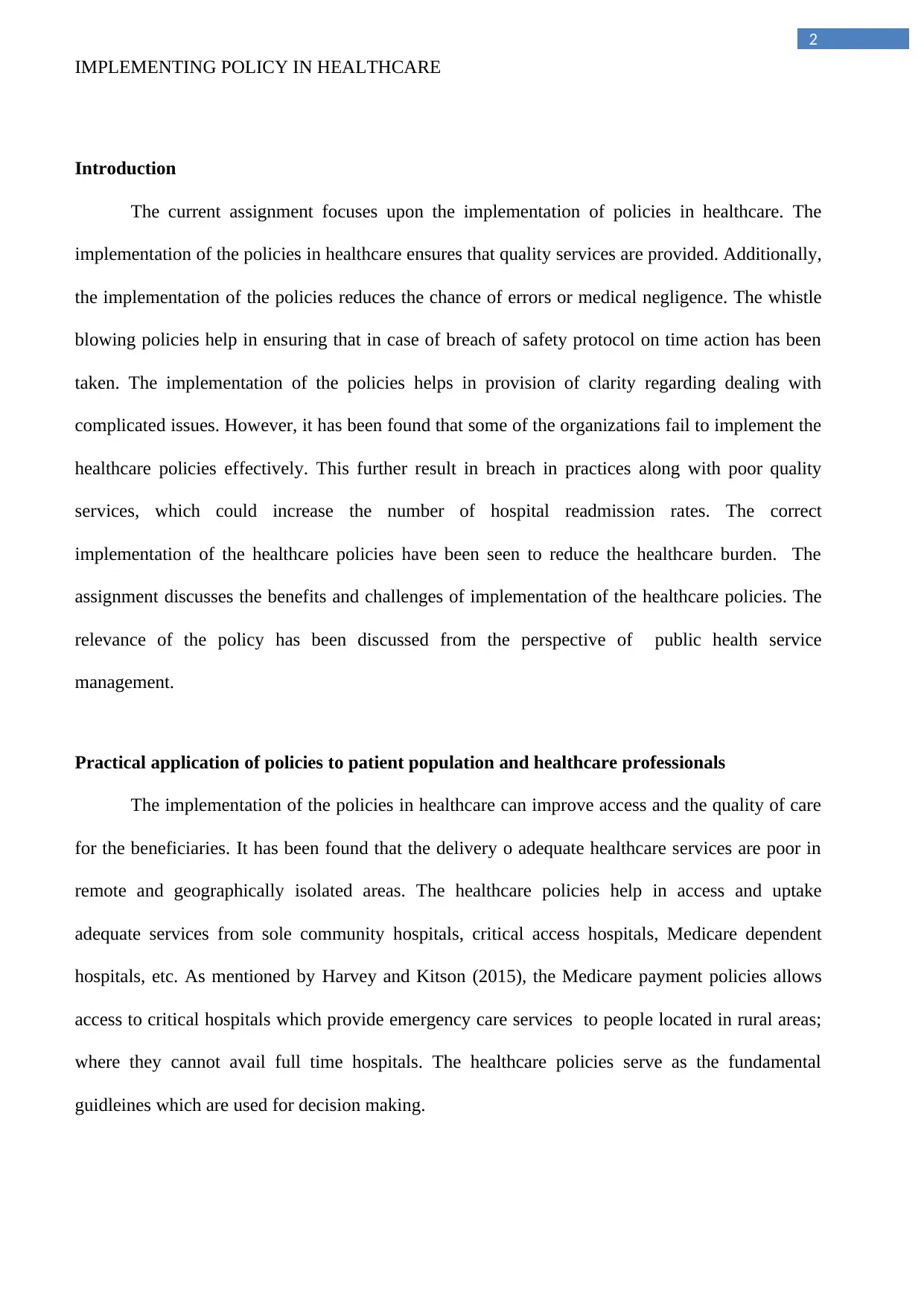
2
IMPLEMENTING POLICY IN HEALTHCARE
Introduction
The current assignment focuses upon the implementation of policies in healthcare. The
implementation of the policies in healthcare ensures that quality services are provided. Additionally,
the implementation of the policies reduces the chance of errors or medical negligence. The whistle
blowing policies help in ensuring that in case of breach of safety protocol on time action has been
taken. The implementation of the policies helps in provision of clarity regarding dealing with
complicated issues. However, it has been found that some of the organizations fail to implement the
healthcare policies effectively. This further result in breach in practices along with poor quality
services, which could increase the number of hospital readmission rates. The correct
implementation of the healthcare policies have been seen to reduce the healthcare burden. The
assignment discusses the benefits and challenges of implementation of the healthcare policies. The
relevance of the policy has been discussed from the perspective of public health service
management.
Practical application of policies to patient population and healthcare professionals
The implementation of the policies in healthcare can improve access and the quality of care
for the beneficiaries. It has been found that the delivery o adequate healthcare services are poor in
remote and geographically isolated areas. The healthcare policies help in access and uptake
adequate services from sole community hospitals, critical access hospitals, Medicare dependent
hospitals, etc. As mentioned by Harvey and Kitson (2015), the Medicare payment policies allows
access to critical hospitals which provide emergency care services to people located in rural areas;
where they cannot avail full time hospitals. The healthcare policies serve as the fundamental
guidleines which are used for decision making.
IMPLEMENTING POLICY IN HEALTHCARE
Introduction
The current assignment focuses upon the implementation of policies in healthcare. The
implementation of the policies in healthcare ensures that quality services are provided. Additionally,
the implementation of the policies reduces the chance of errors or medical negligence. The whistle
blowing policies help in ensuring that in case of breach of safety protocol on time action has been
taken. The implementation of the policies helps in provision of clarity regarding dealing with
complicated issues. However, it has been found that some of the organizations fail to implement the
healthcare policies effectively. This further result in breach in practices along with poor quality
services, which could increase the number of hospital readmission rates. The correct
implementation of the healthcare policies have been seen to reduce the healthcare burden. The
assignment discusses the benefits and challenges of implementation of the healthcare policies. The
relevance of the policy has been discussed from the perspective of public health service
management.
Practical application of policies to patient population and healthcare professionals
The implementation of the policies in healthcare can improve access and the quality of care
for the beneficiaries. It has been found that the delivery o adequate healthcare services are poor in
remote and geographically isolated areas. The healthcare policies help in access and uptake
adequate services from sole community hospitals, critical access hospitals, Medicare dependent
hospitals, etc. As mentioned by Harvey and Kitson (2015), the Medicare payment policies allows
access to critical hospitals which provide emergency care services to people located in rural areas;
where they cannot avail full time hospitals. The healthcare policies serve as the fundamental
guidleines which are used for decision making.
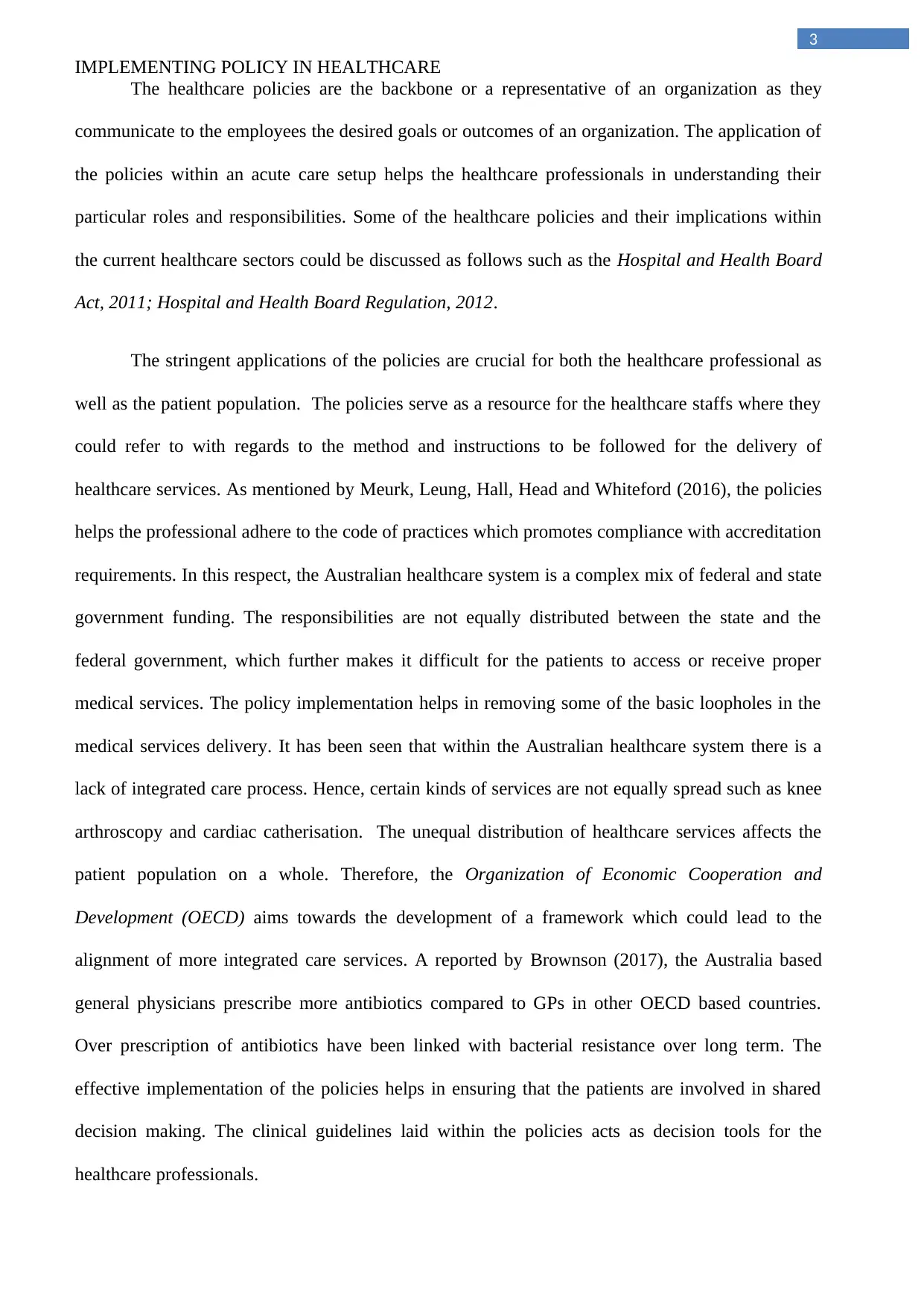
3
IMPLEMENTING POLICY IN HEALTHCARE
The healthcare policies are the backbone or a representative of an organization as they
communicate to the employees the desired goals or outcomes of an organization. The application of
the policies within an acute care setup helps the healthcare professionals in understanding their
particular roles and responsibilities. Some of the healthcare policies and their implications within
the current healthcare sectors could be discussed as follows such as the Hospital and Health Board
Act, 2011; Hospital and Health Board Regulation, 2012.
The stringent applications of the policies are crucial for both the healthcare professional as
well as the patient population. The policies serve as a resource for the healthcare staffs where they
could refer to with regards to the method and instructions to be followed for the delivery of
healthcare services. As mentioned by Meurk, Leung, Hall, Head and Whiteford (2016), the policies
helps the professional adhere to the code of practices which promotes compliance with accreditation
requirements. In this respect, the Australian healthcare system is a complex mix of federal and state
government funding. The responsibilities are not equally distributed between the state and the
federal government, which further makes it difficult for the patients to access or receive proper
medical services. The policy implementation helps in removing some of the basic loopholes in the
medical services delivery. It has been seen that within the Australian healthcare system there is a
lack of integrated care process. Hence, certain kinds of services are not equally spread such as knee
arthroscopy and cardiac catherisation. The unequal distribution of healthcare services affects the
patient population on a whole. Therefore, the Organization of Economic Cooperation and
Development (OECD) aims towards the development of a framework which could lead to the
alignment of more integrated care services. A reported by Brownson (2017), the Australia based
general physicians prescribe more antibiotics compared to GPs in other OECD based countries.
Over prescription of antibiotics have been linked with bacterial resistance over long term. The
effective implementation of the policies helps in ensuring that the patients are involved in shared
decision making. The clinical guidelines laid within the policies acts as decision tools for the
healthcare professionals.
IMPLEMENTING POLICY IN HEALTHCARE
The healthcare policies are the backbone or a representative of an organization as they
communicate to the employees the desired goals or outcomes of an organization. The application of
the policies within an acute care setup helps the healthcare professionals in understanding their
particular roles and responsibilities. Some of the healthcare policies and their implications within
the current healthcare sectors could be discussed as follows such as the Hospital and Health Board
Act, 2011; Hospital and Health Board Regulation, 2012.
The stringent applications of the policies are crucial for both the healthcare professional as
well as the patient population. The policies serve as a resource for the healthcare staffs where they
could refer to with regards to the method and instructions to be followed for the delivery of
healthcare services. As mentioned by Meurk, Leung, Hall, Head and Whiteford (2016), the policies
helps the professional adhere to the code of practices which promotes compliance with accreditation
requirements. In this respect, the Australian healthcare system is a complex mix of federal and state
government funding. The responsibilities are not equally distributed between the state and the
federal government, which further makes it difficult for the patients to access or receive proper
medical services. The policy implementation helps in removing some of the basic loopholes in the
medical services delivery. It has been seen that within the Australian healthcare system there is a
lack of integrated care process. Hence, certain kinds of services are not equally spread such as knee
arthroscopy and cardiac catherisation. The unequal distribution of healthcare services affects the
patient population on a whole. Therefore, the Organization of Economic Cooperation and
Development (OECD) aims towards the development of a framework which could lead to the
alignment of more integrated care services. A reported by Brownson (2017), the Australia based
general physicians prescribe more antibiotics compared to GPs in other OECD based countries.
Over prescription of antibiotics have been linked with bacterial resistance over long term. The
effective implementation of the policies helps in ensuring that the patients are involved in shared
decision making. The clinical guidelines laid within the policies acts as decision tools for the
healthcare professionals.
Secure Best Marks with AI Grader
Need help grading? Try our AI Grader for instant feedback on your assignments.
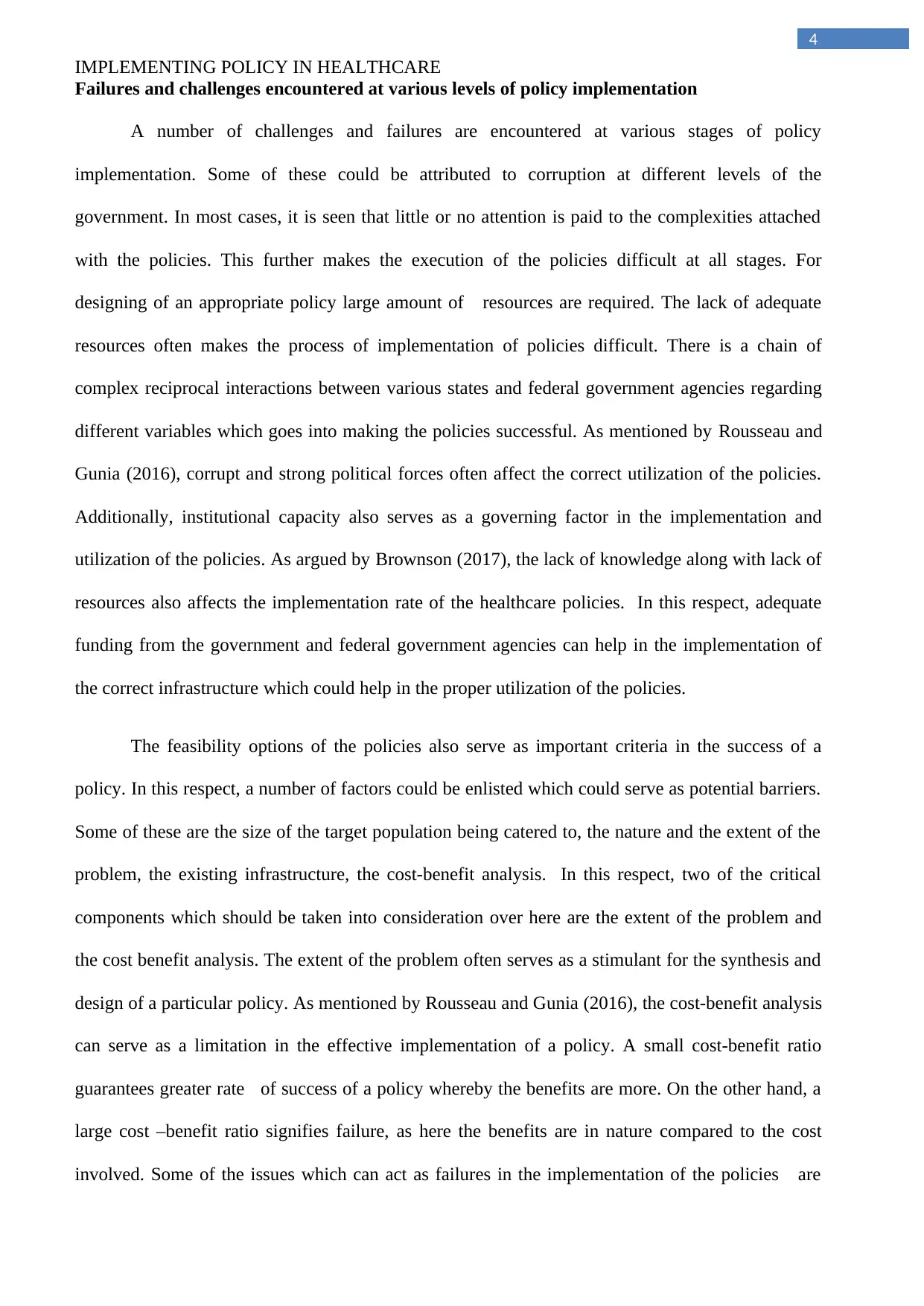
4
IMPLEMENTING POLICY IN HEALTHCARE
Failures and challenges encountered at various levels of policy implementation
A number of challenges and failures are encountered at various stages of policy
implementation. Some of these could be attributed to corruption at different levels of the
government. In most cases, it is seen that little or no attention is paid to the complexities attached
with the policies. This further makes the execution of the policies difficult at all stages. For
designing of an appropriate policy large amount of resources are required. The lack of adequate
resources often makes the process of implementation of policies difficult. There is a chain of
complex reciprocal interactions between various states and federal government agencies regarding
different variables which goes into making the policies successful. As mentioned by Rousseau and
Gunia (2016), corrupt and strong political forces often affect the correct utilization of the policies.
Additionally, institutional capacity also serves as a governing factor in the implementation and
utilization of the policies. As argued by Brownson (2017), the lack of knowledge along with lack of
resources also affects the implementation rate of the healthcare policies. In this respect, adequate
funding from the government and federal government agencies can help in the implementation of
the correct infrastructure which could help in the proper utilization of the policies.
The feasibility options of the policies also serve as important criteria in the success of a
policy. In this respect, a number of factors could be enlisted which could serve as potential barriers.
Some of these are the size of the target population being catered to, the nature and the extent of the
problem, the existing infrastructure, the cost-benefit analysis. In this respect, two of the critical
components which should be taken into consideration over here are the extent of the problem and
the cost benefit analysis. The extent of the problem often serves as a stimulant for the synthesis and
design of a particular policy. As mentioned by Rousseau and Gunia (2016), the cost-benefit analysis
can serve as a limitation in the effective implementation of a policy. A small cost-benefit ratio
guarantees greater rate of success of a policy whereby the benefits are more. On the other hand, a
large cost –benefit ratio signifies failure, as here the benefits are in nature compared to the cost
involved. Some of the issues which can act as failures in the implementation of the policies are
IMPLEMENTING POLICY IN HEALTHCARE
Failures and challenges encountered at various levels of policy implementation
A number of challenges and failures are encountered at various stages of policy
implementation. Some of these could be attributed to corruption at different levels of the
government. In most cases, it is seen that little or no attention is paid to the complexities attached
with the policies. This further makes the execution of the policies difficult at all stages. For
designing of an appropriate policy large amount of resources are required. The lack of adequate
resources often makes the process of implementation of policies difficult. There is a chain of
complex reciprocal interactions between various states and federal government agencies regarding
different variables which goes into making the policies successful. As mentioned by Rousseau and
Gunia (2016), corrupt and strong political forces often affect the correct utilization of the policies.
Additionally, institutional capacity also serves as a governing factor in the implementation and
utilization of the policies. As argued by Brownson (2017), the lack of knowledge along with lack of
resources also affects the implementation rate of the healthcare policies. In this respect, adequate
funding from the government and federal government agencies can help in the implementation of
the correct infrastructure which could help in the proper utilization of the policies.
The feasibility options of the policies also serve as important criteria in the success of a
policy. In this respect, a number of factors could be enlisted which could serve as potential barriers.
Some of these are the size of the target population being catered to, the nature and the extent of the
problem, the existing infrastructure, the cost-benefit analysis. In this respect, two of the critical
components which should be taken into consideration over here are the extent of the problem and
the cost benefit analysis. The extent of the problem often serves as a stimulant for the synthesis and
design of a particular policy. As mentioned by Rousseau and Gunia (2016), the cost-benefit analysis
can serve as a limitation in the effective implementation of a policy. A small cost-benefit ratio
guarantees greater rate of success of a policy whereby the benefits are more. On the other hand, a
large cost –benefit ratio signifies failure, as here the benefits are in nature compared to the cost
involved. Some of the issues which can act as failures in the implementation of the policies are
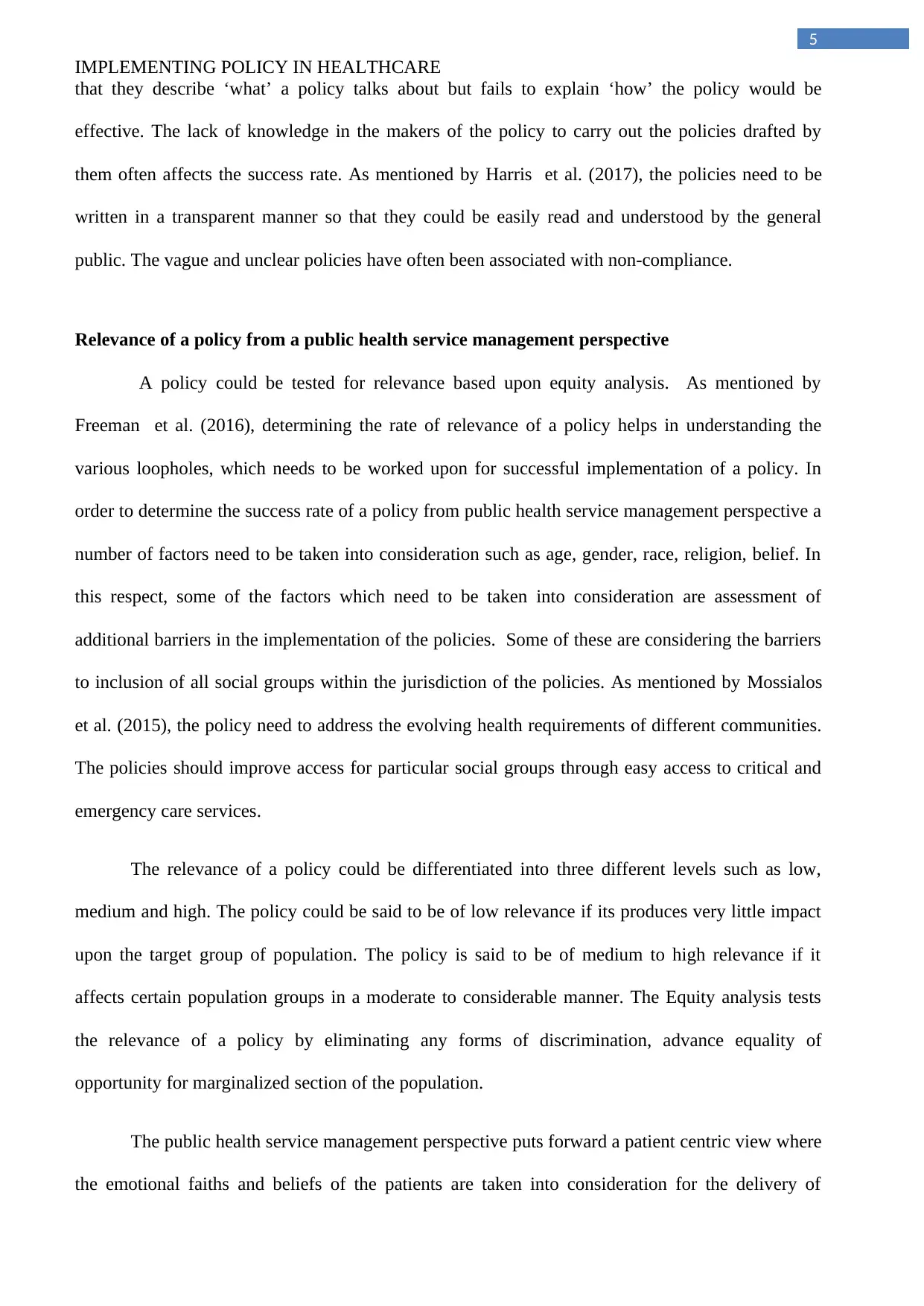
5
IMPLEMENTING POLICY IN HEALTHCARE
that they describe ‘what’ a policy talks about but fails to explain ‘how’ the policy would be
effective. The lack of knowledge in the makers of the policy to carry out the policies drafted by
them often affects the success rate. As mentioned by Harris et al. (2017), the policies need to be
written in a transparent manner so that they could be easily read and understood by the general
public. The vague and unclear policies have often been associated with non-compliance.
Relevance of a policy from a public health service management perspective
A policy could be tested for relevance based upon equity analysis. As mentioned by
Freeman et al. (2016), determining the rate of relevance of a policy helps in understanding the
various loopholes, which needs to be worked upon for successful implementation of a policy. In
order to determine the success rate of a policy from public health service management perspective a
number of factors need to be taken into consideration such as age, gender, race, religion, belief. In
this respect, some of the factors which need to be taken into consideration are assessment of
additional barriers in the implementation of the policies. Some of these are considering the barriers
to inclusion of all social groups within the jurisdiction of the policies. As mentioned by Mossialos
et al. (2015), the policy need to address the evolving health requirements of different communities.
The policies should improve access for particular social groups through easy access to critical and
emergency care services.
The relevance of a policy could be differentiated into three different levels such as low,
medium and high. The policy could be said to be of low relevance if its produces very little impact
upon the target group of population. The policy is said to be of medium to high relevance if it
affects certain population groups in a moderate to considerable manner. The Equity analysis tests
the relevance of a policy by eliminating any forms of discrimination, advance equality of
opportunity for marginalized section of the population.
The public health service management perspective puts forward a patient centric view where
the emotional faiths and beliefs of the patients are taken into consideration for the delivery of
IMPLEMENTING POLICY IN HEALTHCARE
that they describe ‘what’ a policy talks about but fails to explain ‘how’ the policy would be
effective. The lack of knowledge in the makers of the policy to carry out the policies drafted by
them often affects the success rate. As mentioned by Harris et al. (2017), the policies need to be
written in a transparent manner so that they could be easily read and understood by the general
public. The vague and unclear policies have often been associated with non-compliance.
Relevance of a policy from a public health service management perspective
A policy could be tested for relevance based upon equity analysis. As mentioned by
Freeman et al. (2016), determining the rate of relevance of a policy helps in understanding the
various loopholes, which needs to be worked upon for successful implementation of a policy. In
order to determine the success rate of a policy from public health service management perspective a
number of factors need to be taken into consideration such as age, gender, race, religion, belief. In
this respect, some of the factors which need to be taken into consideration are assessment of
additional barriers in the implementation of the policies. Some of these are considering the barriers
to inclusion of all social groups within the jurisdiction of the policies. As mentioned by Mossialos
et al. (2015), the policy need to address the evolving health requirements of different communities.
The policies should improve access for particular social groups through easy access to critical and
emergency care services.
The relevance of a policy could be differentiated into three different levels such as low,
medium and high. The policy could be said to be of low relevance if its produces very little impact
upon the target group of population. The policy is said to be of medium to high relevance if it
affects certain population groups in a moderate to considerable manner. The Equity analysis tests
the relevance of a policy by eliminating any forms of discrimination, advance equality of
opportunity for marginalized section of the population.
The public health service management perspective puts forward a patient centric view where
the emotional faiths and beliefs of the patients are taken into consideration for the delivery of

6
IMPLEMENTING POLICY IN HEALTHCARE
effective care services. As mentioned by Brownson, Baker, Deshpande and Gillespie (2017), the
queries put forward the patient population during the medical encounters should be adequately
answered, as the emotions and the risk factors involved are much high in healthcare. The relevance
of the policy is measured based upon two such important factors which are knowledge and action.
The policy should document the important parameters which need to be taken into consideration for
the delivery of the support care services in a particular way. It should effectively contain the
guidelines based upon which the physician or the attending healthcare professional handle
complicated or critical cases. Some of the common themes based upon the above points which
could be discussed over here are the cost –benefit analysis of particular healthcare policies. The
policies need to be designed in a manner so that it could make certain features of healthcare services
easily accessible to all at cost-effective prices (Prasad & Ioannidis, 2014). Additionally, the policies
should be free of any vague clause as they increase the chance of failures manifold times.
Usefulness of the policy to improve equity in health access
Health equity is one of the important factors which provide equal access to healthcare
services to most of the population groups. As mentioned by Grajales III, Sheps, Ho, Novak-
Lauscher and Eysenbach (2014), health equity has often been linked to socio-economic background.
It has been seen that the ones who are poor or belong to the downtrodden sections of the society
suffer from more incidences of illness compared to others. In this respect, changes brought about in
social factors can bring about considerable changes in the health outcomes. Some of the key factors
which could be promoted over here are maximum social inclusion and affordability. The policies
should aim towards the provision of medical services though improved technologies such as mobile
medical vans (Lindquist, Tracy & Snyder, 2018). As mentioned by Islam, Kwak, Kabir, Hossain
and Kwak (2015), the health inclusion policies helps in provision of affordable medical services to
the poor or marginalised section of the society. The mobile medical technologies could help in
provision of primary and emergency care services in remote areas. Some of these technologies and
IMPLEMENTING POLICY IN HEALTHCARE
effective care services. As mentioned by Brownson, Baker, Deshpande and Gillespie (2017), the
queries put forward the patient population during the medical encounters should be adequately
answered, as the emotions and the risk factors involved are much high in healthcare. The relevance
of the policy is measured based upon two such important factors which are knowledge and action.
The policy should document the important parameters which need to be taken into consideration for
the delivery of the support care services in a particular way. It should effectively contain the
guidelines based upon which the physician or the attending healthcare professional handle
complicated or critical cases. Some of the common themes based upon the above points which
could be discussed over here are the cost –benefit analysis of particular healthcare policies. The
policies need to be designed in a manner so that it could make certain features of healthcare services
easily accessible to all at cost-effective prices (Prasad & Ioannidis, 2014). Additionally, the policies
should be free of any vague clause as they increase the chance of failures manifold times.
Usefulness of the policy to improve equity in health access
Health equity is one of the important factors which provide equal access to healthcare
services to most of the population groups. As mentioned by Grajales III, Sheps, Ho, Novak-
Lauscher and Eysenbach (2014), health equity has often been linked to socio-economic background.
It has been seen that the ones who are poor or belong to the downtrodden sections of the society
suffer from more incidences of illness compared to others. In this respect, changes brought about in
social factors can bring about considerable changes in the health outcomes. Some of the key factors
which could be promoted over here are maximum social inclusion and affordability. The policies
should aim towards the provision of medical services though improved technologies such as mobile
medical vans (Lindquist, Tracy & Snyder, 2018). As mentioned by Islam, Kwak, Kabir, Hossain
and Kwak (2015), the health inclusion policies helps in provision of affordable medical services to
the poor or marginalised section of the society. The mobile medical technologies could help in
provision of primary and emergency care services in remote areas. Some of these technologies and
Paraphrase This Document
Need a fresh take? Get an instant paraphrase of this document with our AI Paraphraser
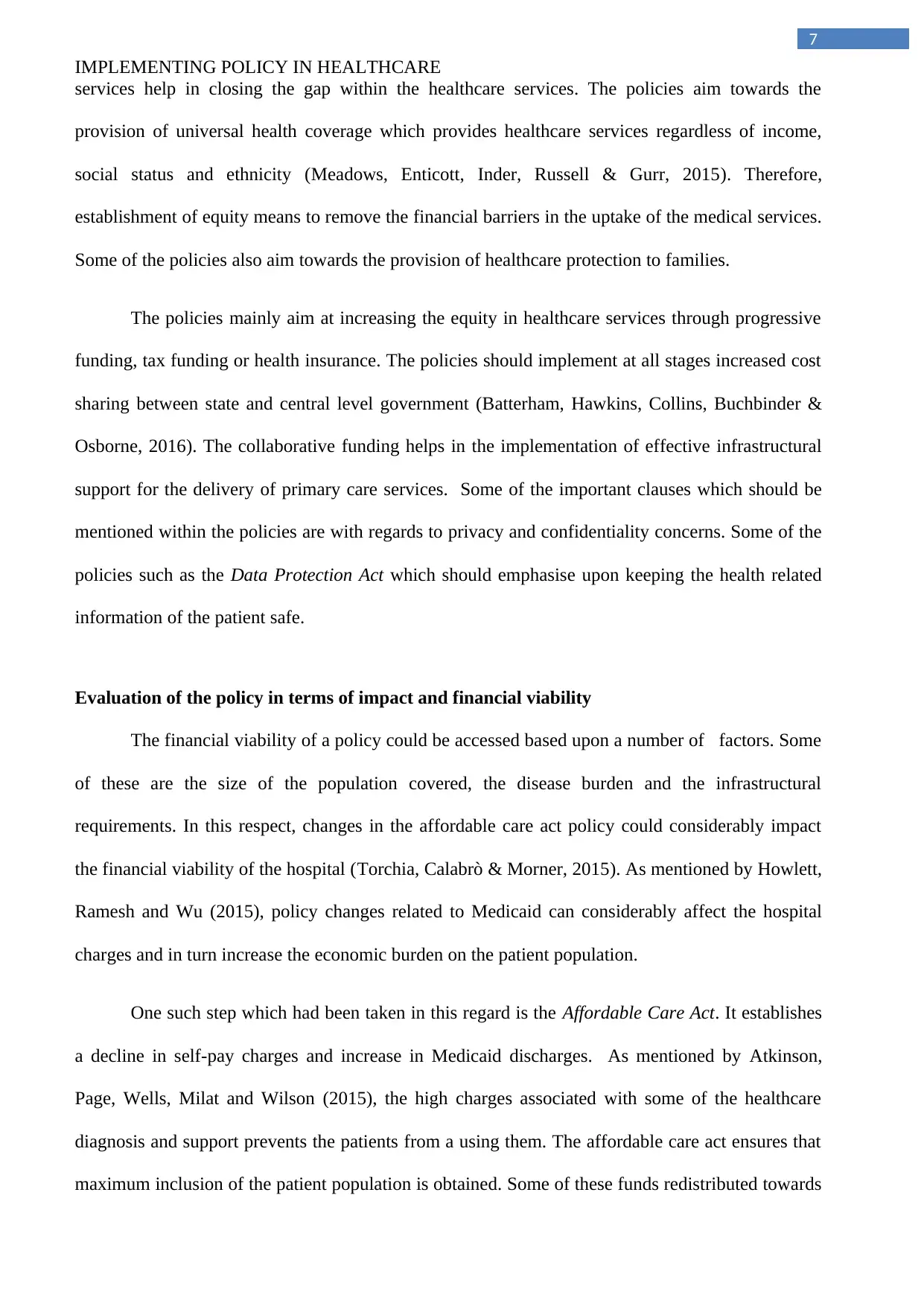
7
IMPLEMENTING POLICY IN HEALTHCARE
services help in closing the gap within the healthcare services. The policies aim towards the
provision of universal health coverage which provides healthcare services regardless of income,
social status and ethnicity (Meadows, Enticott, Inder, Russell & Gurr, 2015). Therefore,
establishment of equity means to remove the financial barriers in the uptake of the medical services.
Some of the policies also aim towards the provision of healthcare protection to families.
The policies mainly aim at increasing the equity in healthcare services through progressive
funding, tax funding or health insurance. The policies should implement at all stages increased cost
sharing between state and central level government (Batterham, Hawkins, Collins, Buchbinder &
Osborne, 2016). The collaborative funding helps in the implementation of effective infrastructural
support for the delivery of primary care services. Some of the important clauses which should be
mentioned within the policies are with regards to privacy and confidentiality concerns. Some of the
policies such as the Data Protection Act which should emphasise upon keeping the health related
information of the patient safe.
Evaluation of the policy in terms of impact and financial viability
The financial viability of a policy could be accessed based upon a number of factors. Some
of these are the size of the population covered, the disease burden and the infrastructural
requirements. In this respect, changes in the affordable care act policy could considerably impact
the financial viability of the hospital (Torchia, Calabrò & Morner, 2015). As mentioned by Howlett,
Ramesh and Wu (2015), policy changes related to Medicaid can considerably affect the hospital
charges and in turn increase the economic burden on the patient population.
One such step which had been taken in this regard is the Affordable Care Act. It establishes
a decline in self-pay charges and increase in Medicaid discharges. As mentioned by Atkinson,
Page, Wells, Milat and Wilson (2015), the high charges associated with some of the healthcare
diagnosis and support prevents the patients from a using them. The affordable care act ensures that
maximum inclusion of the patient population is obtained. Some of these funds redistributed towards
IMPLEMENTING POLICY IN HEALTHCARE
services help in closing the gap within the healthcare services. The policies aim towards the
provision of universal health coverage which provides healthcare services regardless of income,
social status and ethnicity (Meadows, Enticott, Inder, Russell & Gurr, 2015). Therefore,
establishment of equity means to remove the financial barriers in the uptake of the medical services.
Some of the policies also aim towards the provision of healthcare protection to families.
The policies mainly aim at increasing the equity in healthcare services through progressive
funding, tax funding or health insurance. The policies should implement at all stages increased cost
sharing between state and central level government (Batterham, Hawkins, Collins, Buchbinder &
Osborne, 2016). The collaborative funding helps in the implementation of effective infrastructural
support for the delivery of primary care services. Some of the important clauses which should be
mentioned within the policies are with regards to privacy and confidentiality concerns. Some of the
policies such as the Data Protection Act which should emphasise upon keeping the health related
information of the patient safe.
Evaluation of the policy in terms of impact and financial viability
The financial viability of a policy could be accessed based upon a number of factors. Some
of these are the size of the population covered, the disease burden and the infrastructural
requirements. In this respect, changes in the affordable care act policy could considerably impact
the financial viability of the hospital (Torchia, Calabrò & Morner, 2015). As mentioned by Howlett,
Ramesh and Wu (2015), policy changes related to Medicaid can considerably affect the hospital
charges and in turn increase the economic burden on the patient population.
One such step which had been taken in this regard is the Affordable Care Act. It establishes
a decline in self-pay charges and increase in Medicaid discharges. As mentioned by Atkinson,
Page, Wells, Milat and Wilson (2015), the high charges associated with some of the healthcare
diagnosis and support prevents the patients from a using them. The affordable care act ensures that
maximum inclusion of the patient population is obtained. Some of these funds redistributed towards

8
IMPLEMENTING POLICY IN HEALTHCARE
effective medical technologies such as are electronic health records, mobile medical van and clinics.
These help in the provision of emergency medical support and trauma care to the poor or the
downtrodden people. Some of the policies such as the Hospital and health board act, 2011 and the
Hospital and health board regulation, 2012, helps in maintaining optimal standards of the care and
support services. The regulations stated in the guide helps in the maintaining effective medication
practices. It also covers the legal aspects and guidelines which are binding upon the medical
professionals and healthcare staffs. The healthcare professionals are expected to act in accordance
with the prevention and confidentiality concerns. The healthcare professionals attending to the
patient population should ensure at no stage of the care delivery process the private or confidential
details of the patient are shared. The health board enlists the parameters which aims towards
acting in a manner, which optimises the well being of the patients by providing them with quality
healthcare services. Some of the methods which have been mentioned within the policies are
following up of an effective note taking and documentation technique (Aldridge et al., 2016).
Additionally, training on the methods and implementation of evidence based approaches can further
impact the quality of healthcare services delivered in a positive manner.
Conclusion
The current study discusses regarding the impact of policies on healthcare. The healthcare
policies could help in the implementation of evidence based approaches. These are aimed at
improving the overall quality of healthcare services by training the physicians on the guidelines and
procedures which could be followed by them to improve the recovery rates of the patients alongside
reduce the chances of medical errors. The healthcare policies apply to different areas such as
medicine administration, emergency trauma care services, and affordable care services.
The policies are aimed towards improving the patient inclusion rate and remove the health
inequalities by making some of the services at available at affordable costs such as mobile medical
services. Additionally, abiding by the policies helps in the effective implementation of the some of
IMPLEMENTING POLICY IN HEALTHCARE
effective medical technologies such as are electronic health records, mobile medical van and clinics.
These help in the provision of emergency medical support and trauma care to the poor or the
downtrodden people. Some of the policies such as the Hospital and health board act, 2011 and the
Hospital and health board regulation, 2012, helps in maintaining optimal standards of the care and
support services. The regulations stated in the guide helps in the maintaining effective medication
practices. It also covers the legal aspects and guidelines which are binding upon the medical
professionals and healthcare staffs. The healthcare professionals are expected to act in accordance
with the prevention and confidentiality concerns. The healthcare professionals attending to the
patient population should ensure at no stage of the care delivery process the private or confidential
details of the patient are shared. The health board enlists the parameters which aims towards
acting in a manner, which optimises the well being of the patients by providing them with quality
healthcare services. Some of the methods which have been mentioned within the policies are
following up of an effective note taking and documentation technique (Aldridge et al., 2016).
Additionally, training on the methods and implementation of evidence based approaches can further
impact the quality of healthcare services delivered in a positive manner.
Conclusion
The current study discusses regarding the impact of policies on healthcare. The healthcare
policies could help in the implementation of evidence based approaches. These are aimed at
improving the overall quality of healthcare services by training the physicians on the guidelines and
procedures which could be followed by them to improve the recovery rates of the patients alongside
reduce the chances of medical errors. The healthcare policies apply to different areas such as
medicine administration, emergency trauma care services, and affordable care services.
The policies are aimed towards improving the patient inclusion rate and remove the health
inequalities by making some of the services at available at affordable costs such as mobile medical
services. Additionally, abiding by the policies helps in the effective implementation of the some of
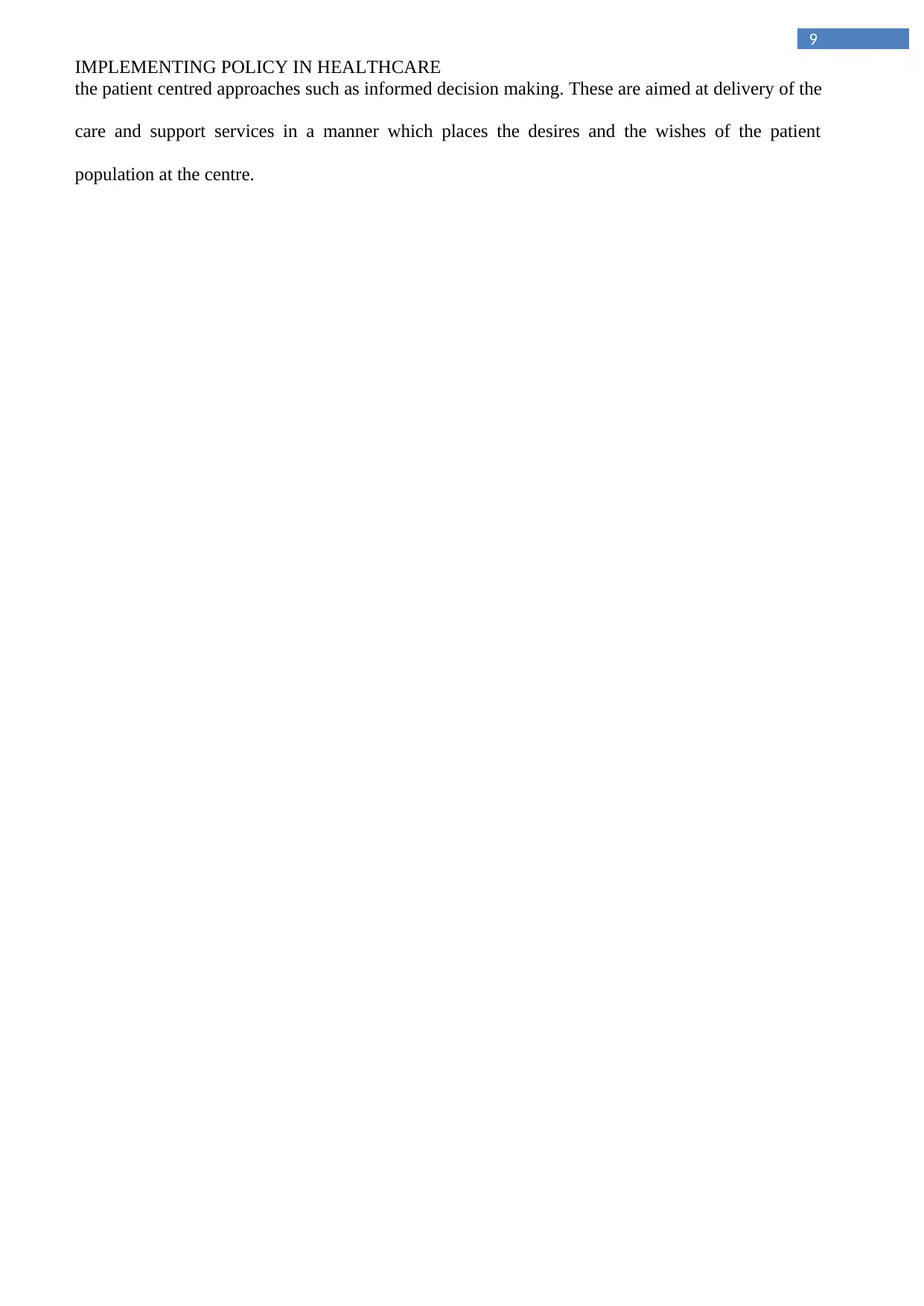
9
IMPLEMENTING POLICY IN HEALTHCARE
the patient centred approaches such as informed decision making. These are aimed at delivery of the
care and support services in a manner which places the desires and the wishes of the patient
population at the centre.
IMPLEMENTING POLICY IN HEALTHCARE
the patient centred approaches such as informed decision making. These are aimed at delivery of the
care and support services in a manner which places the desires and the wishes of the patient
population at the centre.
Secure Best Marks with AI Grader
Need help grading? Try our AI Grader for instant feedback on your assignments.
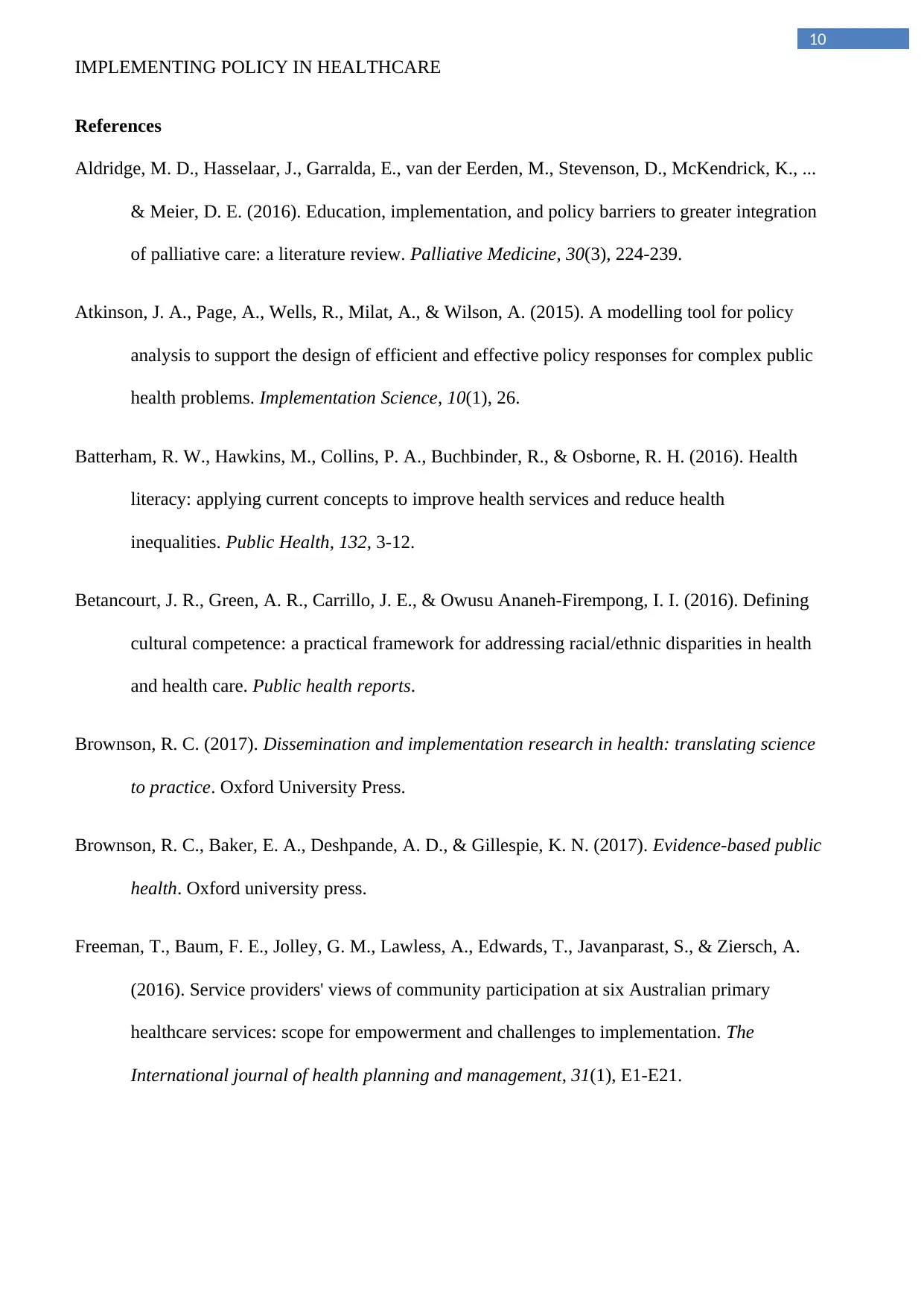
10
IMPLEMENTING POLICY IN HEALTHCARE
References
Aldridge, M. D., Hasselaar, J., Garralda, E., van der Eerden, M., Stevenson, D., McKendrick, K., ...
& Meier, D. E. (2016). Education, implementation, and policy barriers to greater integration
of palliative care: a literature review. Palliative Medicine, 30(3), 224-239.
Atkinson, J. A., Page, A., Wells, R., Milat, A., & Wilson, A. (2015). A modelling tool for policy
analysis to support the design of efficient and effective policy responses for complex public
health problems. Implementation Science, 10(1), 26.
Batterham, R. W., Hawkins, M., Collins, P. A., Buchbinder, R., & Osborne, R. H. (2016). Health
literacy: applying current concepts to improve health services and reduce health
inequalities. Public Health, 132, 3-12.
Betancourt, J. R., Green, A. R., Carrillo, J. E., & Owusu Ananeh-Firempong, I. I. (2016). Defining
cultural competence: a practical framework for addressing racial/ethnic disparities in health
and health care. Public health reports.
Brownson, R. C. (2017). Dissemination and implementation research in health: translating science
to practice. Oxford University Press.
Brownson, R. C., Baker, E. A., Deshpande, A. D., & Gillespie, K. N. (2017). Evidence-based public
health. Oxford university press.
Freeman, T., Baum, F. E., Jolley, G. M., Lawless, A., Edwards, T., Javanparast, S., & Ziersch, A.
(2016). Service providers' views of community participation at six Australian primary
healthcare services: scope for empowerment and challenges to implementation. The
International journal of health planning and management, 31(1), E1-E21.
IMPLEMENTING POLICY IN HEALTHCARE
References
Aldridge, M. D., Hasselaar, J., Garralda, E., van der Eerden, M., Stevenson, D., McKendrick, K., ...
& Meier, D. E. (2016). Education, implementation, and policy barriers to greater integration
of palliative care: a literature review. Palliative Medicine, 30(3), 224-239.
Atkinson, J. A., Page, A., Wells, R., Milat, A., & Wilson, A. (2015). A modelling tool for policy
analysis to support the design of efficient and effective policy responses for complex public
health problems. Implementation Science, 10(1), 26.
Batterham, R. W., Hawkins, M., Collins, P. A., Buchbinder, R., & Osborne, R. H. (2016). Health
literacy: applying current concepts to improve health services and reduce health
inequalities. Public Health, 132, 3-12.
Betancourt, J. R., Green, A. R., Carrillo, J. E., & Owusu Ananeh-Firempong, I. I. (2016). Defining
cultural competence: a practical framework for addressing racial/ethnic disparities in health
and health care. Public health reports.
Brownson, R. C. (2017). Dissemination and implementation research in health: translating science
to practice. Oxford University Press.
Brownson, R. C., Baker, E. A., Deshpande, A. D., & Gillespie, K. N. (2017). Evidence-based public
health. Oxford university press.
Freeman, T., Baum, F. E., Jolley, G. M., Lawless, A., Edwards, T., Javanparast, S., & Ziersch, A.
(2016). Service providers' views of community participation at six Australian primary
healthcare services: scope for empowerment and challenges to implementation. The
International journal of health planning and management, 31(1), E1-E21.
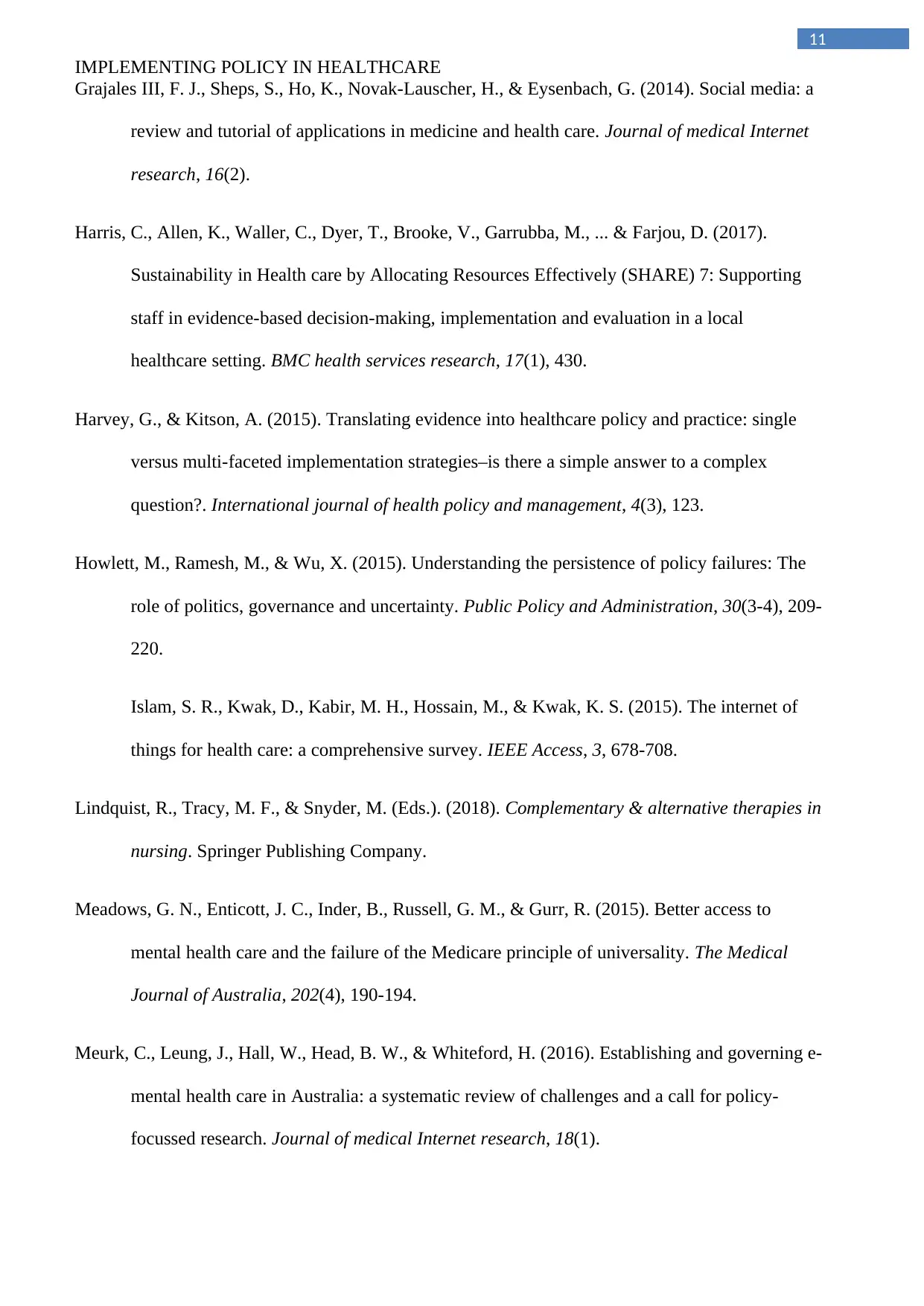
11
IMPLEMENTING POLICY IN HEALTHCARE
Grajales III, F. J., Sheps, S., Ho, K., Novak-Lauscher, H., & Eysenbach, G. (2014). Social media: a
review and tutorial of applications in medicine and health care. Journal of medical Internet
research, 16(2).
Harris, C., Allen, K., Waller, C., Dyer, T., Brooke, V., Garrubba, M., ... & Farjou, D. (2017).
Sustainability in Health care by Allocating Resources Effectively (SHARE) 7: Supporting
staff in evidence-based decision-making, implementation and evaluation in a local
healthcare setting. BMC health services research, 17(1), 430.
Harvey, G., & Kitson, A. (2015). Translating evidence into healthcare policy and practice: single
versus multi-faceted implementation strategies–is there a simple answer to a complex
question?. International journal of health policy and management, 4(3), 123.
Howlett, M., Ramesh, M., & Wu, X. (2015). Understanding the persistence of policy failures: The
role of politics, governance and uncertainty. Public Policy and Administration, 30(3-4), 209-
220.
Islam, S. R., Kwak, D., Kabir, M. H., Hossain, M., & Kwak, K. S. (2015). The internet of
things for health care: a comprehensive survey. IEEE Access, 3, 678-708.
Lindquist, R., Tracy, M. F., & Snyder, M. (Eds.). (2018). Complementary & alternative therapies in
nursing. Springer Publishing Company.
Meadows, G. N., Enticott, J. C., Inder, B., Russell, G. M., & Gurr, R. (2015). Better access to
mental health care and the failure of the Medicare principle of universality. The Medical
Journal of Australia, 202(4), 190-194.
Meurk, C., Leung, J., Hall, W., Head, B. W., & Whiteford, H. (2016). Establishing and governing e-
mental health care in Australia: a systematic review of challenges and a call for policy-
focussed research. Journal of medical Internet research, 18(1).
IMPLEMENTING POLICY IN HEALTHCARE
Grajales III, F. J., Sheps, S., Ho, K., Novak-Lauscher, H., & Eysenbach, G. (2014). Social media: a
review and tutorial of applications in medicine and health care. Journal of medical Internet
research, 16(2).
Harris, C., Allen, K., Waller, C., Dyer, T., Brooke, V., Garrubba, M., ... & Farjou, D. (2017).
Sustainability in Health care by Allocating Resources Effectively (SHARE) 7: Supporting
staff in evidence-based decision-making, implementation and evaluation in a local
healthcare setting. BMC health services research, 17(1), 430.
Harvey, G., & Kitson, A. (2015). Translating evidence into healthcare policy and practice: single
versus multi-faceted implementation strategies–is there a simple answer to a complex
question?. International journal of health policy and management, 4(3), 123.
Howlett, M., Ramesh, M., & Wu, X. (2015). Understanding the persistence of policy failures: The
role of politics, governance and uncertainty. Public Policy and Administration, 30(3-4), 209-
220.
Islam, S. R., Kwak, D., Kabir, M. H., Hossain, M., & Kwak, K. S. (2015). The internet of
things for health care: a comprehensive survey. IEEE Access, 3, 678-708.
Lindquist, R., Tracy, M. F., & Snyder, M. (Eds.). (2018). Complementary & alternative therapies in
nursing. Springer Publishing Company.
Meadows, G. N., Enticott, J. C., Inder, B., Russell, G. M., & Gurr, R. (2015). Better access to
mental health care and the failure of the Medicare principle of universality. The Medical
Journal of Australia, 202(4), 190-194.
Meurk, C., Leung, J., Hall, W., Head, B. W., & Whiteford, H. (2016). Establishing and governing e-
mental health care in Australia: a systematic review of challenges and a call for policy-
focussed research. Journal of medical Internet research, 18(1).
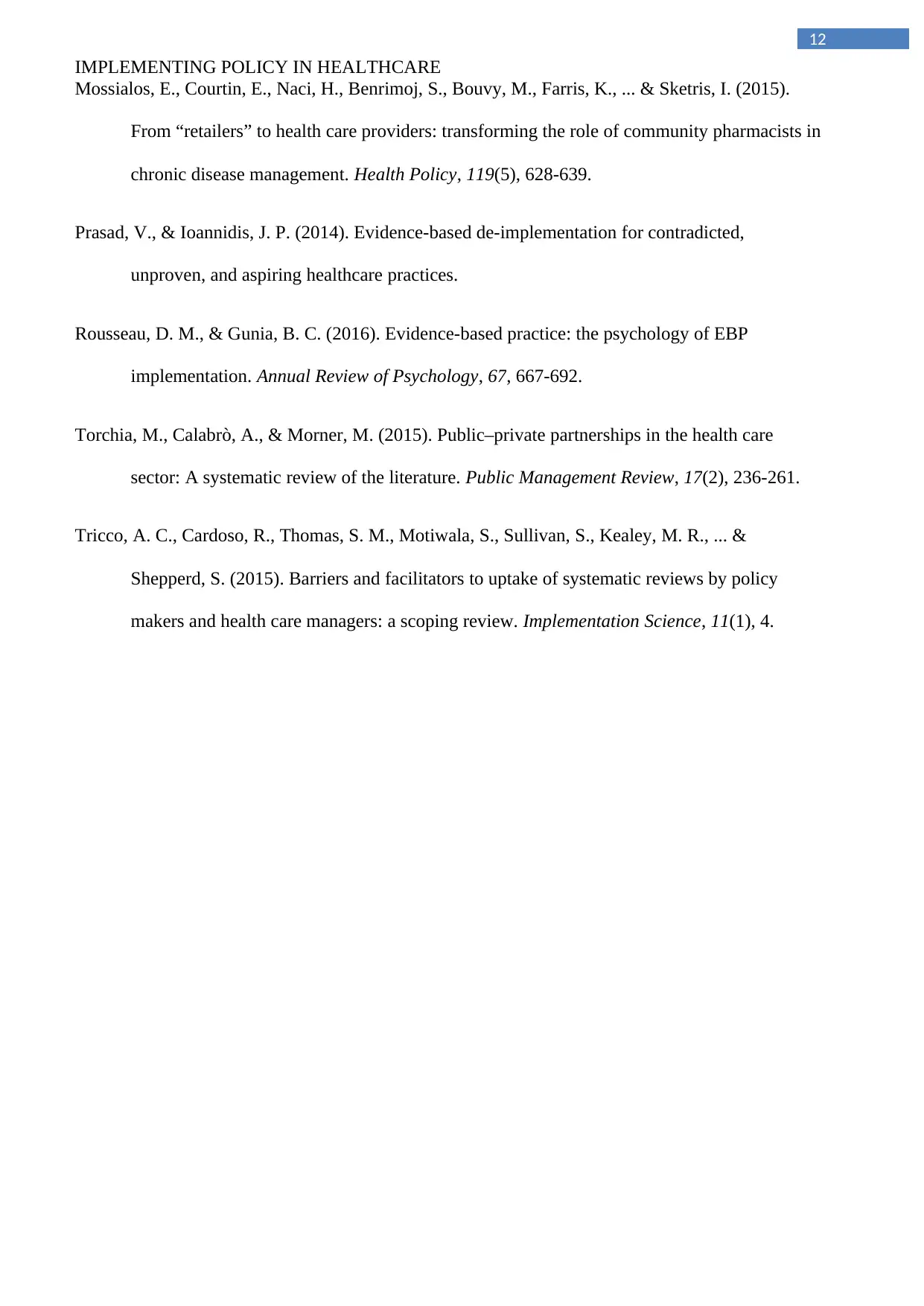
12
IMPLEMENTING POLICY IN HEALTHCARE
Mossialos, E., Courtin, E., Naci, H., Benrimoj, S., Bouvy, M., Farris, K., ... & Sketris, I. (2015).
From “retailers” to health care providers: transforming the role of community pharmacists in
chronic disease management. Health Policy, 119(5), 628-639.
Prasad, V., & Ioannidis, J. P. (2014). Evidence-based de-implementation for contradicted,
unproven, and aspiring healthcare practices.
Rousseau, D. M., & Gunia, B. C. (2016). Evidence-based practice: the psychology of EBP
implementation. Annual Review of Psychology, 67, 667-692.
Torchia, M., Calabrò, A., & Morner, M. (2015). Public–private partnerships in the health care
sector: A systematic review of the literature. Public Management Review, 17(2), 236-261.
Tricco, A. C., Cardoso, R., Thomas, S. M., Motiwala, S., Sullivan, S., Kealey, M. R., ... &
Shepperd, S. (2015). Barriers and facilitators to uptake of systematic reviews by policy
makers and health care managers: a scoping review. Implementation Science, 11(1), 4.
IMPLEMENTING POLICY IN HEALTHCARE
Mossialos, E., Courtin, E., Naci, H., Benrimoj, S., Bouvy, M., Farris, K., ... & Sketris, I. (2015).
From “retailers” to health care providers: transforming the role of community pharmacists in
chronic disease management. Health Policy, 119(5), 628-639.
Prasad, V., & Ioannidis, J. P. (2014). Evidence-based de-implementation for contradicted,
unproven, and aspiring healthcare practices.
Rousseau, D. M., & Gunia, B. C. (2016). Evidence-based practice: the psychology of EBP
implementation. Annual Review of Psychology, 67, 667-692.
Torchia, M., Calabrò, A., & Morner, M. (2015). Public–private partnerships in the health care
sector: A systematic review of the literature. Public Management Review, 17(2), 236-261.
Tricco, A. C., Cardoso, R., Thomas, S. M., Motiwala, S., Sullivan, S., Kealey, M. R., ... &
Shepperd, S. (2015). Barriers and facilitators to uptake of systematic reviews by policy
makers and health care managers: a scoping review. Implementation Science, 11(1), 4.
1 out of 13
Related Documents
Your All-in-One AI-Powered Toolkit for Academic Success.
+13062052269
info@desklib.com
Available 24*7 on WhatsApp / Email
![[object Object]](/_next/static/media/star-bottom.7253800d.svg)
Unlock your academic potential
© 2024 | Zucol Services PVT LTD | All rights reserved.





